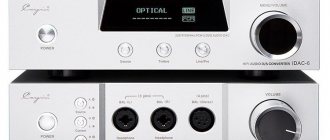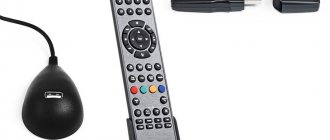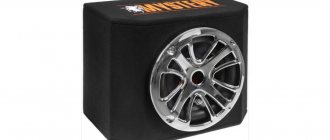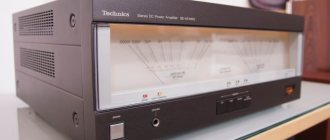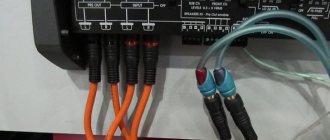Specifications Technics SU-A600
- Output power: 40 W per channel into 8 ohms and 60 W into 4 ohms load
- Frequency response: 20 Hz to 20 kHz
- Harmonic Distortion Level: 0.01%
- Input sensitivity: 2.5 mV
- Signal to noise ratio: 76 dB
- Channel Separation: 50 dB
- Speaker load impedance: 4 ohms to 16 ohms
- Dimensions: 430 x 125 x 318 mm
- Weight: 6.1 kg
- Year of manufacture: 1997
| On the back wall there are connectors designed to connect 2 pairs of acoustics. | |
| Special power transformer on an R-type core to reduce stray fields. |
| X-Pro series of power filter capacitors to provide high peak currents to the load |
The declared power of the amplifier (up to 60 watts) with a nonlinear distortion coefficient of less than 0.01% will be enough for even complex modern acoustics to play as its manufacturer intended.
Damping factor amplifier
The amplifier's high damping factor is stated to be no lower than 60. This contributes to excellent sound with any acoustics. Well, otherwise I can say this: the oscillatory movement of the diffuser sets the impact of the bass drum in the track. In theory, there should be only one oscillation. In theory, other vibrations (movement of the diffuser to its original position - inertial movements) should be damped by the amplifier. But if the amplifier's damping rate is low, then the diffuser will be able to produce the sounds of that drum several more times. Instead of one blow, the dedamped diffuser will move for some more time, but with a smaller amplitude.
How can this affect the sound produced by the speaker? Since only the woofer (low-frequency) speaker has active and deep movements of the diffuser, this can be expressed in the form of a booming and incomprehensible sound that “smears” the entire low-frequency spectrum. Not one clear blow will be heard, but a series of short, fading sounds. So, if this indicator is higher, the music will sound better.
The speaker itself, structurally, is also mechanically damped. This is displayed in its parameters with the value “Q factor”. There is a lot of controversy about this parameter, since it is not easy to calculate it and achieve perfection in the existing amplifier and acoustics. This is mostly a subjective parameter, but it is quite important when choosing an amplifier.
Control comes first
This solution, which is not the most common for this price category (and it is also used in the SE-R1 reference series, which is not yet presented in all countries), is dictated by the company’s new approach, which can be freely expressed by the well-known expression “are you checkered or go?”
In other words, Technics is committed to providing you with precise, detailed, and musical sound with confident control over a variety of acoustics—using the methods they choose.
To protect against internal interference, a three-node arrangement was used in the amplifier
To begin with, in order to eliminate the almost inevitable jitter and accompanying noise when processing a digital signal, the company used proprietary JENO Engine (Jitter Elimination and Noise-shaping Optimization) technology. In particular, a special battery-powered clock generator and a precision PWM module are involved here.
The main control lies with LAPC (Load Adaptive Phase Calibration) technology, which adjusts the phase characteristics in real time, continuously matching them to the constantly changing and frequency-dependent impedance of the speakers. As a result, engineers were able to obtain a smooth, powerful signal across the entire frequency range.
Internal partitions increase the rigidity of the already strong case
The Japanese paid special attention to protection from parasitic noise and radiation. First of all, the amplifier case was divided into three almost equal parts, placing in them various circuits and a switching hybrid power supply. Internal partitions also added additional rigidity and vibration resistance to the already robust aluminum body on a double frame and a steel bottom plate.
More noise-reducing circuits and components were added to the power supply, computer input amplifier, clock power supply, and phono input.
However, Technics has not completely forgotten about the variation on the theme of its own AA amplification circuit (and again not to be confused with the operating mode) - it is used in the headphone output. Here, the high PWM signal, converted to analog, is fed to a separate dual-circuit amplifier.
Amplifier tone block
The amplifier has a button - Direct mode, which allows you to disable the tone block from the path. This is also a good trick. Because it becomes possible to use a separate pre-amplifier. And, by default, it can be much cooler than the one built into the final amplifier. Therefore, if it is possible to use a separate pre-amplifier unit, then it is worth using it. And our amplifier will simply amplify the signal.
First person
If now we listened to digital recordings with a deliciously prepared analog conversion from Cambridge Audio Edge NQ, which the amplifier then re-digitized, now we will compare this presentation with our own processing from the Technics SU-G700 itself. And the source here will be the native CD/network player Technics Super Audio CD SL-G700, connected via a coaxial interface.
The large volume knob is so pleasant to the touch that you want to put the remote control aside and get up from your chair once again
I go through the same musical material - and everywhere the same volumetric, balanced presentation is preserved, but the sound has become a little lighter, cooler and more transparent. Whether this is a plus or a minus is a matter of personal taste. But when choosing an amplifier, you need to keep two things in mind: it can reliably reveal the features of an analog source, and, at the same time, it has its own character when processing an external digital signal.
Overall, I got the impression that the Technics SU-G700 is capable of handling any soundtrack and getting everything out of the recording, regardless of genre. And every time it will be a high-quality, voluminous and effective presentation. By the way, during the entire listening, the volume level was approximately 30–40% of the maximum.
Do you think there are a lot of flattering words? Well, here’s the cherry on the cake - yes, the sound of the amplifier is emphatically correct, but to such an extent that you already want some individual nuances. This machine reminds me of the Asian virtuosos who populate prestigious classical music competitions.
They may have an impeccably correct technique, honed by countless persistent repetitions, but they resemble ideal and therefore similar musical robots. So the Technics SU-G700 seems to offer a mathematical model of a sound that is perfect in its understanding, when sometimes you want something from the heart.
Amplifier class Technics SU-A600
A very bright part of the “pluses” of the Technics SU-A600 amplifier is the “AA” amplifier mode. This mode was described in Radio magazine in 1998. No. 5. on pages 56-57. A description of the circuit and principle of operation in the “AA” mode will not tell anything interesting to a simple user of the device.
But I’ll tell you the gist of it. It summarizes the following: “The amplifier operating in “AA” mode is characterized by extremely low non-linear distortion of up to 0.005%.” And this is a very excellent indicator for an amplifier!
It also follows from the article that “Technics” amplifiers of the SE-A1000, SU-A700MK3, Su-A800D, Su-A900D models work with similar circuitry. Which differ significantly in power and other characteristics from the model being described. But the principle of the amplifier is the same. This means the sound quality should be excellent!
If you find an error, please select a piece of text and press Ctrl+Enter.
